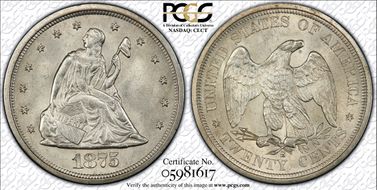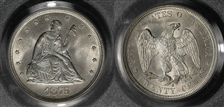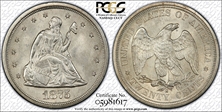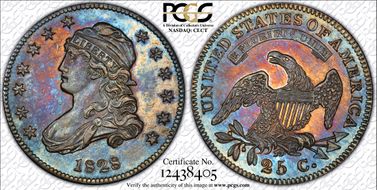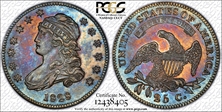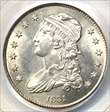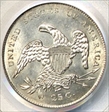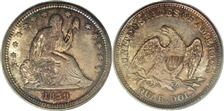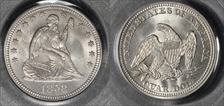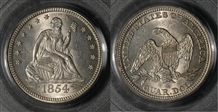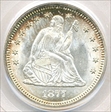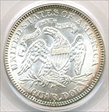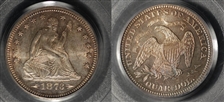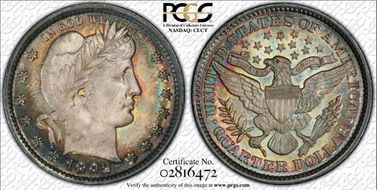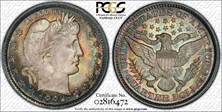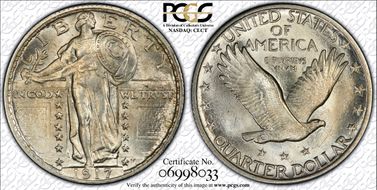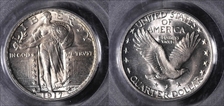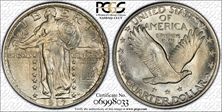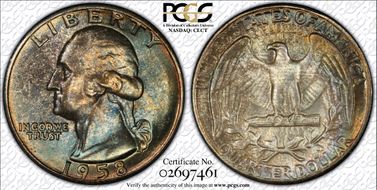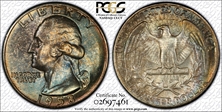Gobrecht's Raisinet Collection 的钱币相册
1828 25C MS62 B-4, R.3 as a business strike, R.7 as a proof. The Narrow Date, B-4 variety has less space between the 82, relative to B-1 through B-3. This specimen is a striking and rather proof-like example of this difficult early quarter type, richly toned in sea-green, plum-red, tan-gold and cobalt-blue. The final date in the Large Diameter series of Bust quarters, and unquestionably original with rich tonal qualities, the striking details are well brought up in all areas and both sides are perfectly centered. The definition of what constitutes a proof has become more strict within past decades. Only a handful of 1828 quarters have been certified as proofs. Speculating on the possibility of it being a proof, the fields do exhibit a noticeable glimmer when held beneath a light, but the effect is somewhat dampened by the layers of toning.
1828 25C MS62 B-4, R.3 as a business strike, R.7 as a proof. The Narrow Date, B-4 variety has less space between the 82, relative to B-1 through B-3. This specimen is a striking and rather proof-like example of this difficult early quarter type, richly toned in sea-green, plum-red, tan-gold and cobalt-blue. The final date in the Large Diameter series of Bust quarters, and unquestionably original with rich tonal qualities, the striking details are well brought up in all areas and both sides are perfectly centered. The definition of what constitutes a proof has become more strict within past decades. Only a handful of 1828 quarters have been certified as proofs. Speculating on the possibility of it being a proof, the fields do exhibit a noticeable glimmer when held beneath a light, but the effect is somewhat dampened by the layers of toning.
1831 25C Small Letters MS64. B-4, R.1. Minage: 398,000. No quarters were struck in 1829 or 1830, and when the denomination resumed production in 1831, the diameter was reduced from 27 mm to 24.3 mm. The weight and alloy were unchanged, which implies that the new quarters were thicker. Half eagles also were reduced in diameter, beginning in 1829, but otherwise retained prior alloy and weight standards. These changes in diameter were made to conform to the new close collar technology introduced to the Philadelphia Mint. However, Capped Bust halves, which then dominated silver coin production, continued to be struck with lettered edges until the 1836 Reeded Edge halves were produced. This is a lustrous and brilliant silver-white example of the Capped Bust quarter dollar design. Star 7 points to lower curl, the lower right star is close to the hair, square based 2 in the denomination, eagle has long tongue, 25 C closer to eagle than dentils, 25 is high and the arrow heads are thin. There are remnants of die rust above and left of the final S in STATES. This is a later die state of the B-4 variety with a fine die crack through the C of the denomination to the stem above, and another connecting the lower left base of the A in AMERICA with the middle serif of F in OF. Repunching shows on the 5 of the denomination. This is Die State III in Walter Breen's revision of the Browning reference, apparently the most common die state of this variety. Only the barest glimpse of a golden patina accompanies this needle-sharp near-Gem. The strike is exquisite and a strong lens reveals only trivial contact. A wonderful type coin from the Age of Jackson from The Lanterman's Mill Collection.
1831 25C Small Letters MS64. B-4, R.1. Minage: 398,000. No quarters were struck in 1829 or 1830, and when the denomination resumed production in 1831, the diameter was reduced from 27 mm to 24.3 mm. The weight and alloy were unchanged, which implies that the new quarters were thicker. Half eagles also were reduced in diameter, beginning in 1829, but otherwise retained prior alloy and weight standards. These changes in diameter were made to conform to the new close collar technology introduced to the Philadelphia Mint. However, Capped Bust halves, which then dominated silver coin production, continued to be struck with lettered edges until the 1836 Reeded Edge halves were produced. This is a lustrous and brilliant silver-white example of the Capped Bust quarter dollar design. Star 7 points to lower curl, the lower right star is close to the hair, square based 2 in the denomination, eagle has long tongue, 25 C closer to eagle than dentils, 25 is high and the arrow heads are thin. There are remnants of die rust above and left of the final S in STATES. This is a later die state of the B-4 variety with a fine die crack through the C of the denomination to the stem above, and another connecting the lower left base of the A in AMERICA with the middle serif of F in OF. Repunching shows on the 5 of the denomination. This is Die State III in Walter Breen's revision of the Browning reference, apparently the most common die state of this variety. Only the barest glimpse of a golden patina accompanies this needle-sharp near-Gem. The strike is exquisite and a strong lens reveals only trivial contact. A wonderful type coin from the Age of Jackson from The Lanterman's Mill Collection.
Lustrous and Attractively Toned MS64 1839 No Drapery Quarter. Closed Claws Reverse. (The 1839 No Drapery is found both with the Closed Claws reverse of 1838, and the Open Claws reverse of 1839.) The device punches for what would become the Seated Liberty Quarter were completed by Christian Gobrecht during the summer of 1838. After 20 "specimens" were sent to Treasury Secretary Levi Woodbury, regular production commenced on September 29. The Philadelphia Mint produced at least 466,000 examples this year, all of which, like their 1839 and 1840-O No Drapery counterparts, lacked obverse drapery folds at Liberty's right (facing) elbow. All three of these issues are scarce in problem-free Uncirculated preservation, and what few coins have been certified at the upper reaches of the Mint State grading scale are usually snatched up quickly by type collectors when they appear on the market. Writing in 1991, Larry Briggs says of this issue: "Head, stars, and obverse dentils are poorly struck." Many examples of this issue are poorly struck, and this piece shows noticeable softness on the upper obverse and the right (facing) quadrant, and correspondingly on the lower reverse. The delectable original toning, in shades of silver-pink and electric blue, compensates somewhat, and there are few signs of contact. Seldom seen finer. From The Palakika Collection.
1858 25C MS65. The high mintage figures for Seated quarters inaugurated by the Mint Act of February 21, 1853 continued at the Philadelphia Mint through 1858. Arrows were removed from the design in 1856 after a three-year run, although they would briefly return in 1873. Although there was no longer a need for a distinguishing feature on the obverse or reverse of the Seated Quarter, mintage figures remained high at the Philadelphia mint from 1856 through 1861. The 1857 boasts the highest total in this group with more than 9.6 million pieces delivered. As such, it is a popular representative of the No Motto type in all grades. The high mintage 1858 Quarter is also one of the few issues of the No Motto type that can occasionally be found at the Gem level. From a large mintage of 7.3 million pieces, the 1858 Seated Liberty quarter is also a popular choice for type collectors seeking a No Motto representative. However, examples are seldom encountered at the Gem level of preservation. The present coin is a magnificent Gem, with pristine, brilliant surfaces and vibrant, frosty mint luster. Both sides are sharply defined by a razor-sharp strike, including the obverse stars and the eagle's neck feathers. The incredible visual appeal of this specimen is off the chart. Richly frosted and undeniably smooth, this coin is crisply detailed in all areas.
1854 25C Arrows MS64. Delicate straw-gold patina graces this lustrous and intricately struck near-Gem. The few minor luster grazes are expected of the grade. High quality examples of the 1854 are always in demand as representatives of the briefly produced Arrows, No Rays, No Motto type.
1877 25C MS66. Type Two Reverse. The 1877 Seated Liberty quarter is more difficult to locate than the mintage of nearly 11 million pieces would suggest. Many examples were melted in 1878 to provide silver bullion for Morgan dollars. The present coin is a well-struck Premium Gem, with lustrous surfaces and gold and violet highlights. The reverse displays extensive die cracks and clash marks.
1877 25C MS66. Type Two Reverse. The 1877 Seated Liberty quarter is more difficult to locate than the mintage of nearly 11 million pieces would suggest. Many examples were melted in 1878 to provide silver bullion for Morgan dollars. The present coin is a well-struck Premium Gem, with lustrous surfaces and gold and violet highlights. The reverse displays extensive die cracks and clash marks.
1892 25C MS66. Mintage: 8,237,245. An impressive Gem with warm golden gray centers that give way to intense gold, violet, crimson, carmine, and other vibrant hues too numerous to mention. Sharply struck from a Type II reverse die with the eagle's right wing covering all but the serif of the E in UNITED. The difference between Type I and Type II quarters can be easily remembered by the mnemonic device "Now you see it, now you don't." On Type Ones, the middle serif of the E in UNITED is about halfway visible, while on Type Two quarters, the eagle's wing covers it.
1892 25C MS66. Mintage: 8,237,245. An impressive Gem with warm golden gray centers that give way to intense gold, violet, crimson, carmine, and other vibrant hues too numerous to mention. Sharply struck from a Type II reverse die with the eagle's right wing covering all but the serif of the E in UNITED. The difference between Type I and Type II quarters can be easily remembered by the mnemonic device "Now you see it, now you don't." On Type Ones, the middle serif of the E in UNITED is about halfway visible, while on Type Two quarters, the eagle's wing covers it.
1917 25C Type 2 MS67 Full Head, Mintage: 13,880,000. Partway through the year, the design of this coin type was modified with the revision labeled Type Two. Liberty no longer had an exposed breast, and three small stars were added to the reverse field below the eagle. Viewed through the macro lens of world history, the design of the Standing Liberty quarter is both ironic and prophetic. Although a few of the key-date 1916 issues were coined, only in early 1917 did the design become widely available. Liberty correctly holds the olive branch of peace in her right (left facing) hand, and in her left she holds a shield of protection and defense, from which she has removed its covering sheath. On the reverse, the eagle flies incorrectly (according to heraldic tradition) to its left, its less-honorable side. Of course 1917 was also the year that the United States entered World War I, after striving for years to maintain a position of neutrality. The present Gem example of this popular type coin has brilliant, untoned surfaces. The bold impression does not wane over either Liberty's head, the shield rivets, or the gown lines. Liberty's head boasts three full leaf sprigs and a clear ear hole. The shield lacks not even a single rivet, with full definition on the horizontal lines. On the reverse, the eagle's breast also displays pleasing overall definition. The sparkling mint frost imparts a silver-white appearance.
1917 25C Type 2 MS67 Full Head, Mintage: 13,880,000. Partway through the year, the design of this coin type was modified with the revision labeled Type Two. Liberty no longer had an exposed breast, and three small stars were added to the reverse field below the eagle. Viewed through the macro lens of world history, the design of the Standing Liberty quarter is both ironic and prophetic. Although a few of the key-date 1916 issues were coined, only in early 1917 did the design become widely available. Liberty correctly holds the olive branch of peace in her right (left facing) hand, and in her left she holds a shield of protection and defense, from which she has removed its covering sheath. On the reverse, the eagle flies incorrectly (according to heraldic tradition) to its left, its less-honorable side. Of course 1917 was also the year that the United States entered World War I, after striving for years to maintain a position of neutrality. The present Gem example of this popular type coin has brilliant, untoned surfaces. The bold impression does not wane over either Liberty's head, the shield rivets, or the gown lines. Liberty's head boasts three full leaf sprigs and a clear ear hole. The shield lacks not even a single rivet, with full definition on the horizontal lines. On the reverse, the eagle's breast also displays pleasing overall definition. The sparkling mint frost imparts a silver-white appearance.
1917 25C Type 2 MS67 Full Head, Mintage: 13,880,000. Partway through the year, the design of this coin type was modified with the revision labeled Type Two. Liberty no longer had an exposed breast, and three small stars were added to the reverse field below the eagle. Viewed through the macro lens of world history, the design of the Standing Liberty quarter is both ironic and prophetic. Although a few of the key-date 1916 issues were coined, only in early 1917 did the design become widely available. Liberty correctly holds the olive branch of peace in her right (left facing) hand, and in her left she holds a shield of protection and defense, from which she has removed its covering sheath. On the reverse, the eagle flies incorrectly (according to heraldic tradition) to its left, its less-honorable side. Of course 1917 was also the year that the United States entered World War I, after striving for years to maintain a position of neutrality. The present Gem example of this popular type coin has brilliant, untoned surfaces. The bold impression does not wane over either Liberty's head, the shield rivets, or the gown lines. Liberty's head boasts three full leaf sprigs and a clear ear hole. The shield lacks not even a single rivet, with full definition on the horizontal lines. On the reverse, the eagle's breast also displays pleasing overall definition. The sparkling mint frost imparts a silver-white appearance.
1958 25C MS66. John Flanagan owes his numismatic fame less to artistic merit than to the fact that he was a man in the man's world of the early 20th century. In 1931, the Treasury Department decided to follow in the footsteps of the Lincoln cent and issue a circulating coin honoring the bicentennial of President George Washington's birth. After an open competition that the Treasury conducted in association with the Washington Bicentennial Commission and the Commission of Fine Arts, judges chose Laura Gardin Fraser's masterful design. Even though art critics had admired Fraser's work since the introduction of the Oregon Trail commemorative half dollar in 1926, Treasury Secretary Andrew W. Mellon's male chauvinism prejudiced the design selection process from the start. His choice, the design by John Flanagan, was confirmed as the winner and upheld even after Ogden L. Mills succeeded to the post of Treasury Secretary in early 1932. While Fraser's superior design remains unknown to all but a handful of numismatic scholars, Flanagan's obviously inferior workmanship can still be admired (albeit in slightly modified form for the state quarter program) on the quarters of today. This piece is a beautiful Superb Gem whose fully lustrous surfaces display pastel antique-gold and soft powder-blue iridescence drifting over the shimmering obverse. The reverse is untoned save for a crescent of tan-russet color near the rim between 9 and 3 o'clock. The underlying mint frost radiates through both sides and both sides are free of even the most inconspicuous bagmark. The design features are well impressed and the above average striking quality completes the tantalizing eye appeal.
1958 25C MS66. John Flanagan owes his numismatic fame less to artistic merit than to the fact that he was a man in the man's world of the early 20th century. In 1931, the Treasury Department decided to follow in the footsteps of the Lincoln cent and issue a circulating coin honoring the bicentennial of President George Washington's birth. After an open competition that the Treasury conducted in association with the Washington Bicentennial Commission and the Commission of Fine Arts, judges chose Laura Gardin Fraser's masterful design. Even though art critics had admired Fraser's work since the introduction of the Oregon Trail commemorative half dollar in 1926, Treasury Secretary Andrew W. Mellon's male chauvinism prejudiced the design selection process from the start. His choice, the design by John Flanagan, was confirmed as the winner and upheld even after Ogden L. Mills succeeded to the post of Treasury Secretary in early 1932. While Fraser's superior design remains unknown to all but a handful of numismatic scholars, Flanagan's obviously inferior workmanship can still be admired (albeit in slightly modified form for the state quarter program) on the quarters of today. This piece is a beautiful Superb Gem whose fully lustrous surfaces display pastel antique-gold and soft powder-blue iridescence drifting over the shimmering obverse. The reverse is untoned save for a crescent of tan-russet color near the rim between 9 and 3 o'clock. The underlying mint frost radiates through both sides and both sides are free of even the most inconspicuous bagmark. The design features are well impressed and the above average striking quality completes the tantalizing eye appeal.




















